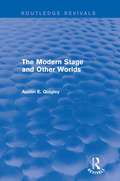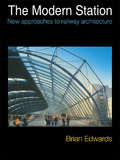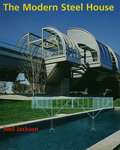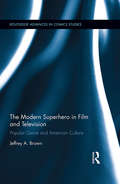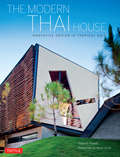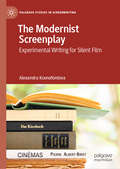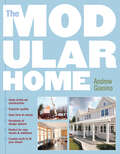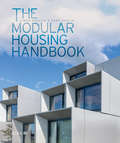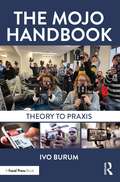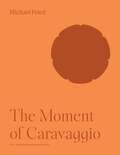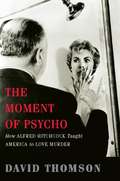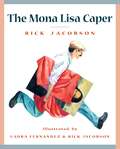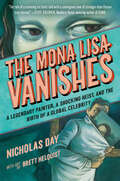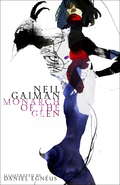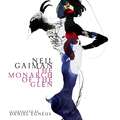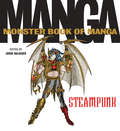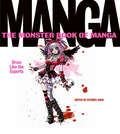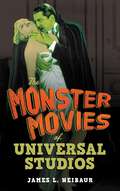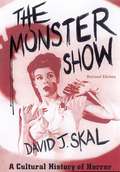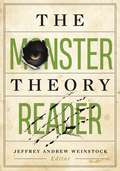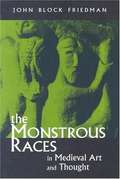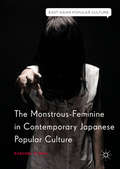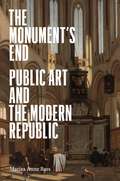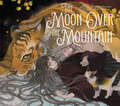- Table View
- List View
The Modern Stage and Other Worlds (Routledge Revivals)
by Austin E. QuigleyModern plays are strikingly diverse and, as a result, any attempt to locate an underlying unity between them encounters difficulties: to focus on what they have in common is often to overlook what is of primary importance in particular plays; to focus on their differences is to note the novelty of the plays without increasing their accessibility. In this study, first published in 1985, Austin E. Quigley takes as his paradigm case the relationship between the world of the stage and the world of the audience, and explores various modes of communication between domains. He asks how changes in the structure of the drama relate to changes in the structure of the theatre, and changes in the role of the audience. Detailed interpretations of plays by Pinero, Ibsen, Strindberg, Brecht, Ionesco, Beckett and Pinter question principles about the modern theatre and establish links between drama structure and theatre structure, theme, and performance space.
The Modern Station: New Approaches to Railway Architecture
by Brian EdwardsAn exciting new generation of railway architecture has emerged in Europe and elsewhere over the past decade. This book explains the reasons for the renaissance of the station as a building type and the current changes it is undergoing. The functional, social and technical factors which shape railway architecture are examined. As stations are essential elements of sustainable development, the environmental benefits of railways are also discussed. Essential guidance is provided for those who design, commission or manage railway stations. By drawing on technical design manuals and examples of recent stations (many designed by leading architects) the book gives help and instruction to all those with an interest in the future of railway architecture.
The Modern Steel House
by Neil JacksonThis book provides a comprehensive survey of Modern Movement houses constructed with steel frames. Arranged chronologically and thematically, it traces the development over the last seventy years of steel houses in Europe, Australia and the United States, with special reference to London, Paris, Sydney and Los Angeles and to the work elsewhere of Mies van der Rohe, Philip Johnson and Jean Prouve. Examples of steel houses from around the world demonstrate that steel structures can provide a better quality of life within a cleaner, lighter home environment.
The Modern Superhero in Film and Television: Popular Genre and American Culture (Routledge Advances in Comics Studies)
by Jeffrey A. BrownHollywood’s live-action superhero films currently dominate the worldwide box-office, with the characters enjoying more notoriety through their feature film and television depictions than they have ever before. This book argues that this immense popularity reveals deep cultural concerns about politics, gender, ethnicity, patriotism and consumerism after the events of 9/11. Superheroes have long been agents of hegemony, fighting for abstract ideals of justice while overall perpetuating the American status quo. Yet at the same time, the book explores how the genre has also been utilized to question and critique these dominant cultural assumptions.
The Modern Thai House
by Robert Powell Albert Lim Ks[A tremendous body of sophisticated and sensitively designed architectural work has been produced in Thailand in the first decade of the 21st century. The 25 houses in The Modern Thai House illustrate the radical new ideas coming from a dynamic younger generation of architects who are producing work comparable with and sometimes even surpassing the very best architecture in the world.] Most of these architects were trained in the U.S. or U.K. and reflect not only American and European sensibilities but also affinities with their contemporaries in Asia-including Japan, China, Singapore, and Bali-all hotbeds for innovation in modern design. The houses in this book are readily accessible from Bangkok, Phuket, and Chiangmai. They reflect a wide variety of concerns and solutions, such as: sustainability; responses to climate; strategies for cooling with minimal electricity; openness versus security in a large metropolis such as Bangkok; cultural sensitivity and responsiveness, as evidenced in a "three-generation house," built for a society in which the extended family is still prevalent; and cultural memory, as in the use of elements such as pilings, verandahs, and steeply pitched roofs with large overhangs that echo traditional Thai designs.[Nurtured by an increasingly knowledgeable and wealthy clientele, modern architecture in Thailand is emerging with a variety of innovative architectural expressions.]
The Modern Thai House
by Robert Powell Albert Lim Ks[A tremendous body of sophisticated and sensitively designed architectural work has been produced in Thailand in the first decade of the 21st century. The 25 houses in The Modern Thai House illustrate the radical new ideas coming from a dynamic younger generation of architects who are producing work comparable with and sometimes even surpassing the very best architecture in the world.] Most of these architects were trained in the U.S. or U.K. and reflect not only American and European sensibilities but also affinities with their contemporaries in Asia-including Japan, China, Singapore, and Bali-all hotbeds for innovation in modern design. The houses in this book are readily accessible from Bangkok, Phuket, and Chiangmai. They reflect a wide variety of concerns and solutions, such as: sustainability; responses to climate; strategies for cooling with minimal electricity; openness versus security in a large metropolis such as Bangkok; cultural sensitivity and responsiveness, as evidenced in a "three-generation house," built for a society in which the extended family is still prevalent; and cultural memory, as in the use of elements such as pilings, verandahs, and steeply pitched roofs with large overhangs that echo traditional Thai designs.[Nurtured by an increasingly knowledgeable and wealthy clientele, modern architecture in Thailand is emerging with a variety of innovative architectural expressions.]
The Modernist Screenplay: Experimental Writing for Silent Film (Palgrave Studies in Screenwriting)
by Alexandra KsenofontovaThe Modernist Screenplay explores the film screenplay as a genre of modernist literature. It connects the history of screenwriting for silent film to the history of literary modernism in France, Germany, and Russia. At the same time, the book considers how the screenplay responded to the modernist crisis of reason, confronted mimetic representation, and sought to overcome the modernist mistrust of language with the help of rhythm. From the silent film projects of Bertolt Brecht, to the screenwriting of Sergei Eisenstein and the poetic scripts of the surrealists, The Modernist Screenplay offers a new angle on the relationship between film and literature. Based on the example of modernist screenwriting, the book proposes a pluralistic approach to screenplays, an approach that sees film scripts both as texts embedded in film production and as literary works in their own right. As a result, the sheer variety of different and experimental ways to tell stories in screenplays comes to light. The Modernist Screenplay explores how the earliest kind of experimental screenplays—the modernist screenplays—challenged normative ideas about the nature of filmmaking, the nature of literary writing, and the borders between the two.
The Modular Home
by Andrew GianinoModular homes are the perfect solution if you want to build a high-quality, customized home without undue expense or hassle. In this informative guide, Andrew Gianino helps you make the best choices throughout the modular building process, with suggestions for everything from choosing the right dealer and contractor to setting the specs, price, and schedule. Whether you’re looking for a cozy Victorian or want to add a personal touch to a wide ranch, there’s a modular home that will fit your tastes, lifestyle, and budget.
The Modular Housing Handbook
by Simon Bayliss Rory BerginModular construction has the potential to improve housing quality, speed up delivery and reduce building costs – so why isn’t everyone doing it? This practical handbook combines real-world advice on designing modular housing with a compelling argument for off-site construction as a means for architects taking a greater role and achieving more influence in their housing projects. Focusing on the benefits as well as the challenges of modular construction, this book illustrates that off-site construction need not act as a design constraint and can in fact provide an opportunity for greater design impact. Richly illustrated with recent case studies and featuring over 100 photographs of exemplar projects, The Modular Housing Handbook provides inspiration as well as timely, practical advice.
The Mojo Handbook: Theory to Praxis
by Ivo BurumThe Mojo Handbook: Theory to Praxis offers a detailed and engaging crash course on how to use mobile tools to create powerful journalistic stories. Drawing on both theoretical underpinnings and practical techniques, the book outlines the fundamentals of mobile journalism methods, by placing mobile storytelling within a wider context of current affairs, documentary filmmaking and public relations. The book offers expert advice for how to use storytelling skills to transform mobile content into engaging and purposeful user-generated stories for audiences. Topics covered include tips for recording dynamic video and clean audio, conducting interviews on your phone and editing and post-production processes, as well as advice on how to handle copyright issues and a primer on journalistic ethics. The book also includes a comprehensive glossary of terms to help students navigate the video production and mobile journalism world. The Mojo Handbook is a valuable resource for aspiring multimedia professionals in journalism, strategic and corporate communication, community and education, as well as anyone looking to incorporate mobile into their visual storytelling tool kit.
The Moment of Caravaggio (The A. W. Mellon Lectures in the Fine Arts #51)
by Michael FriedA major reevaluation of Caravaggio from one of today's leading art historiansThis is a groundbreaking examination of one of the most important artists in the Western tradition by one of the leading art historians and critics of the past half-century. In his first extended consideration of the Italian Baroque painter Michelangelo Merisi da Caravaggio (1573-1610), Michael Fried offers a transformative account of the artist's revolutionary achievement. Based on the A. W. Mellon Lectures in the Fine Arts delivered at the National Gallery of Art, The Moment of Caravaggio displays Fried's unique combination of interpretive brilliance, historical seriousness, and theoretical sophistication, providing sustained and unexpected readings of a wide range of major works, from the early Boy Bitten by a Lizard to the late Martyrdom of Saint Ursula. The result is an electrifying new perspective on a crucial episode in the history of European painting.Focusing on the emergence of the full-blown "gallery picture" in Rome during the last decade of the sixteenth century and the first decades of the seventeenth, Fried draws forth an expansive argument, one that leads to a radically revisionist account of Caravaggio's relation to the self-portrait; of the role of extreme violence in his art, as epitomized by scenes of decapitation; and of the deep structure of his epoch-defining realism. Fried also gives considerable attention to the art of Caravaggio's great rival, Annibale Carracci, as well as to the work of Caravaggio's followers, including Orazio and Artemisia Gentileschi, Bartolomeo Manfredi, and Valentin de Boulogne.Please note: All images in this ebook are presented in black and white and have been reduced in size.
The Moment of Psycho: How Alfred Hitchcock Taught America to Love Murder
by David ThomsonIt was made like a television movie, and completed in less than three months. It killed off its star in forty minutes. There was no happy ending. And it offered the most violent scene to date in American film, punctuated by shrieking strings that seared the national consciousness. Nothing like Psycho had existed before; the movie industry-even America itself-would never be the same. In The Moment of Psycho, film critic David Thomson situates Psycho in Alfred Hitchcock’s career, recreating the mood and time when the seminal film erupted onto film screens worldwide. Thomson shows that Psycho was not just a sensation in film: it altered the very nature of our desires. Sex, violence, and horror took on new life. Psycho, all of a sudden, represented all America wanted from a film-and, as Thomson brilliantly demonstrates, still does.
The Mona Lisa Caper
by Rick Jacobson Laura FernandezThe Mona Lisa Caper is based on true events that began to unfold on Monday, August 21, 1911, when Vincenzo Perugia shocked the world by stealing the most famous of the many treasures in the Louvre. Though Vincenzo was a thief, he meant well. <P> <P> He simply wanted to return the painting to the Italian people in the mistaken belief that it had been stolen from them. Eventually, inevitably, Vincenzo was captured in Florence and put on trial. Italians gave him their hearts for his patriotism. In fact, he received so much food, wine, clothing, and furniture, that he had to be moved to a larger cell! Throughout Rick Jacobson’s lively text, Mona Lisa herself narrates the story of her trip back to the city of her creation. The playful art Rick has painted along with his wife, Laura Fernandez, heightens the fun. Not only is it Keystone-Cops funny, it is a sound introduction to the painting that continues to delight, amaze, and mystify hundreds of years after Leonardo da Vinci’s death.
The Mona Lisa Vanishes: A Legendary Painter, a Shocking Heist, and the Birth of a Global Celebrity
by Nicholas DayOn a hot August day in Paris, just over a century ago, a desperate guard burst into the office of the director of the Louvre and shouted, La Joconde, c’est partie! The Mona Lisa, she’s gone! <P><P> No one knew who was behind the heist. Was it an international gang of thieves? Was it an art-hungry American millionaire? Was it the young Spanish painter Pablo Picasso, who was about to remake the very art of painting? <P><P> Travel back to an extraordinary period of revolutionary change: turn-of-the-century Paris. Walk its backstreets. Meet the infamous thieves—and detectives—of the era. And then slip back further in time and follow Leonardo da Vinci, painter of the Mona Lisa, through his dazzling, wondrously weird life. Discover the secret at the heart of the Mona Lisa—the most famous painting in the world should never have existed at all. <P><P> Here is a middle-grade nonfiction, with black-and-white illustrations by Brett Helquist throughout, written at the pace of a thriller, shot through with stories of crime and celebrity, genius and beauty.
The Monarch of the Glen
by Neil GaimanThe Monarch of the Glen by bestselling storytelling legend Neil Gaiman is American Gods world novella that will thrill Games of Thrones devotees and Terry Pratchett fans alike. 'Original, engrossing, an endlessly entertaining' George R.R Martin on American GodsHe was not sure what he had been looking for. He only knew that he had not found it.Shadow Moon has been away from America for nearly two years. His nights are broken with dangerous dreams. Sometimes he almost believes he doesn't care if he ever returns home. In the Highlands of Scotland, where the sky is pale white and it feels as remote as any place can possibly be, the beautiful and the wealthy gather at a grand old house in the glen. And when the strange local doctor offers him work at the party, Shadow is intrigued. He knows there is no good reason for him to be there. So what do they want with him?**Also available in Fragile Things. Please note this is a black and white ebook**
The Monarch of the Glen
by Neil GaimanHe was not sure what he had been looking for. He only knew that he had not found it.Shadow Moon has been away from America for nearly two years. His nights are broken with dangerous dreams. Sometimes he almost believes he doesn't care if he ever returns home. In the Highlands of Scotland, where the sky is pale white and it feels as remote as any place can possibly be, the beautiful and the wealthy gather at a grand old house in the glen. And when the strange local doctor offers him work at the party, Shadow is intrigued. He knows there is no good reason for him to be there. So what do they want with him?**Also available in Fragile Things**(P)2006 HarperCollins Publishers
The Monster Book of Manga Steampunk Gothic
by Jorge BalaguerEnter an alternative world ruled by steam-powered machinery, Victorian elegance, and futuristic technology by creating your own elaborate manga characters in Steampunk, the latest volume in the bestselling Monster Book of Manga series.This easy-to-follow guidebook brings to life more than thirty avant-garde manga characters fit for a steampunk universe where fantasy, science, and history collide. Through advanced illustration techniques and step-by-step instructions, you'll learn how to easily transform rough sketches into intricately inked graphics, all adorned in clockwork motifs, rich colors, and Space Age attire. Characters include pirates, sci-fi soldiers, industrial aviators, witches, time travelers, robots, and vampires. Whether you're a novice or a skilled artist, The Monster Book of Manga: Steampunk is the definitive guide to creating your very own collection of steampunk manga characters.
The Monster Book of Manga: Draw Like the Experts
by Estudio JosoLearn to draw manga with this great value, monster-sized practical sourcebook of hundreds of step-by-step manga drawings. The most popular manga figures and themes are covered - girls, boys, monsters, samurai, fantasy and science fiction. The popularity of manga comics and graphic novels continues to grow in the UK, inspiring considerable interest in learning how to draw in this exciting style. The Monster Book of Manga is divided into sections focusing on the most popular manga themes. Each figure is broken down into six stages, accompanied by step-by-step instructions, taking the reader from an initial black and white sketch to the final colour artwork. Throughout there are many practical suggestions, hints and tips. In addition, there are useful sections on anatomy, lighting and the digital studio.
The Monster Movies of Universal Studios
by James L NeibaurThis history and critique of classic scary films &“honors Universal&’s horror legacy. . . . an excellent resource for film students and monster movie fanatics&” (Library Journal). In 1931 Universal Studios released Dracula starring Bela Lugosi. This box office success was followed by a string of films featuring macabre characters and chilling atmospherics, including Frankenstein, The Mummy, and The Invisible Man. With each new film, Universal established its place in the Hollywood firmament as the leading producer of horror films, a status it enjoyed for more than twenty years. In The Monster Movies of Universal Studios, James L. Neibaur examines the key films produced by the studio from the early 1930s through the mid-1950s. In each entry, Neibaur recounts the movie&’s production, provides critical commentary, considers the film&’s commercial reception, and offers an overall assessment of the movie&’s significance. Neibaur also examines the impact these films had on popular culture, an influence that resonates in the cinema of fear today. From the world premiere of Dracula to the 1956 release of The Creature Walks among Us, Universal excelled at scaring viewers of all ages—and even elicited a few chuckles along the way by pitting their iconic creatures against the comedic pair of Abbott and Costello. The Monster Movies of Universal Studios captures the thrills of these films, making this book a treat for fans of the golden age of horror cinema. &“Studio stills and trade ads for several of the films add a suitably scary touch to this treat for fans and scholars alike. ― Booklist &“An impressive work of film scholarship.&” ― Cinema Retro
The Monster Show: A Cultural History of Horror
by David J. SkalIlluminating the dark side of the American century, The Monster Show uncovers the surprising links between horror entertainment and the great social crises of our time, as well as horror's function as a pop analogue to surrealism and other artistic movements. With penetrating analyses and revealing anecdotes, David J. Skal chronicles one of our most popular and pervasive modes of cultural expression. He explores the disguised form in which Hollywood's classic horror movies played out the traumas of two world wars and the Depression; the nightmare visions of invasion and mind control catalyzed by the Cold War; the preoccupation with demon children that took hold as thalidomide, birth control, and abortion changed the reproductive landscape; the vogue in visceral, transformative special effects that paralleled the development of the plastic surgery industry; the link between the AIDS epidemic and the current fascination with vampires; and much more. Now with a new Afterword by the author that looks at horror's popular renaissance in the last decade, The Monster Show is a compulsively readable, thought-provoking inquiry into America's obsession with the macabre.
The Monster Theory Reader
by Jeffrey Andrew WeinstockA collection of scholarship on monsters and their meaning—across genres, disciplines, methodologies, and time—from foundational texts to the most recent contributions Zombies and vampires, banshees and basilisks, demons and wendigos, goblins, gorgons, golems, and ghosts. From the mythical monstrous races of the ancient world to the murderous cyborgs of our day, monsters have haunted the human imagination, giving shape to the fears and desires of their time. And as long as there have been monsters, there have been attempts to make sense of them, to explain where they come from and what they mean. This book collects the best of what contemporary scholars have to say on the subject, in the process creating a map of the monstrous across the vast and complex terrain of the human psyche.Editor Jeffrey Andrew Weinstock prepares the way with a genealogy of monster theory, traveling from the earliest explanations of monsters through psychoanalysis, poststructuralism, and cultural studies, to the development of monster theory per se—and including Jeffrey Jerome Cohen&’s foundational essay &“Monster Theory (Seven Theses),&” reproduced here in its entirety. There follow sections devoted to the terminology and concepts used in talking about monstrosity; the relevance of race, religion, gender, class, sexuality, and physical appearance; the application of monster theory to contemporary cultural concerns such as ecology, religion, and terrorism; and finally the possibilities monsters present for envisioning a different future. Including the most interesting and important proponents of monster theory and its progenitors, from Sigmund Freud to Julia Kristeva to J. Halberstam, Donna Haraway, Barbara Creed, and Stephen T. Asma—as well as harder-to-find contributions such as Robin Wood&’s and Masahiro Mori&’s—this is the most extensive and comprehensive collection of scholarship on monsters and monstrosity across disciplines and methods ever to be assembled and will serve as an invaluable resource for students of the uncanny in all its guises.Contributors: Stephen T. Asma, Columbia College Chicago; Timothy K. Beal, Case Western Reserve U; Harry Benshoff, U of North Texas; Bettina Bildhauer, U of St. Andrews; Noel Carroll, The Graduate Center, CUNY; Jeffrey Jerome Cohen, Arizona State U; Barbara Creed, U of Melbourne; Michael Dylan Foster, UC Davis; Sigmund Freud; Elizabeth Grosz, Duke U; J. Halberstam, Columbia U; Donna Haraway, UC Santa Cruz; Julia Kristeva, Paris Diderot U; Anthony Lioi, The Julliard School; Patricia MacCormack, Anglia Ruskin U; Masahiro Mori; Annalee Newitz; Jasbir K. Puar, Rutgers U; Amit A. Rai, Queen Mary U of London; Margrit Shildrick, Stockholm U; Jon Stratton, U of South Australia; Erin Suzuki, UC San Diego; Robin Wood, York U; Alexa Wright, U of Westminster.
The Monstrous Races In Medieval Art And Thought (Medieval Studies)
by John Block FriedmanDuring the Middle Ages, travellers in Africa and Asia reported that monstrous races thrived beyond the boundaries of the known world. This work offers an introspective look at these races and their interaction with Western art, literature and philosophy.
The Monstrous-Feminine in Contemporary Japanese Popular Culture (East Asian Popular Culture)
by Raechel DumasThis book explores the monstrous-feminine in Japanese popular culture, produced from the late years of the 1980s through to the new millennium. Raechel Dumas examines the role of female monsters in selected works of fiction, manga, film, and video games, offering a trans-genre, trans-media analysis of this enduring trope. The book focuses on several iterations of the monstrous-feminine in contemporary Japan: the self-replicating shōjo in horror, monstrous mothers in science fiction, female ghosts and suburban hauntings in cinema, female monsters and public violence in survival horror games, and the rebellious female body in mytho-fiction. Situating the titles examined here amid discourses of crisis that have materialized in contemporary Japan, Dumas illuminates the ambivalent pleasure of the monstrous-feminine as a trope that both articulates anxieties centered on shifting configurations of subjectivity and nationhood, and elaborates novel possibilities for identity negotiation and social formation in a period marked by dramatic change.
The Monument’s End: Public Art and the Modern Republic
by Marisa Anne BassHow today&’s questions surrounding monuments and the ways we commemorate our past first arose in Rembrandt&’s timeMonuments occupy a controversial place in nations founded on principles of freedom and self-governance. It is no accident that when we think of monuments, we think of statues modeled on legacies of conquest, domination, and violence. The Monument&’s End reveals how the artists, architects, poets, and scholars of the early modern Netherlands contended with the profound disconnect between the public monument and the ideals of republican government. Their experiences offer vital lessons about the making, reception, and destruction of monuments in the present.In the seventeenth century, the newly formed Dutch Republic dominated world trade and colonized vast overseas territories even as it sought to shed the trappings of its imperial past. Marisa Anne Bass describes the frustrated attempts by figures such as Rembrandt van Rijn and playwright and poet Joost van den Vondel to reimagine public memory for their emergent nation. She shows how the most celebrated age of Dutch art was more an age of bronze than of gold, one in which the pursuit of freedom from domination was constantly challenged by the commercial ambitions of empire.Exploring how the artists and intellectuals of this vibrant century asked questions that still resonate today, this beautifully illustrated book discusses works by contemporary artists such as Spencer Finch and Thomas Hirschhorn and offers new perspectives on monuments like the 9/11 Memorial and Museum and events such as the Unite the Right rally in Charlottesville.
The Moon Over the Mountain: Maiden's Bookshelf (Maiden's Bookshelf #2)
by Atsushi NakajimaThe Maiden&’s Bookshelf series combines classic short stories of the early 20th century with gorgeous original artwork to create collectible editions for a contemporary audience.At what cost art?In the course of a routine journey, government inspector Yuan Can encounters his old friend Li Zheng—but not as he remembers him. Transformed by obsession into a hideous beast, Li Zheng spins a tragic tale, and ultimately presents his confidante with a singular request. Dressed in the trappings of 8th-century China, Atsushi Nakajima&’s meditation on poetry and friendship nevertheless transcends time and language to speak directly to our hearts about what it means to be human. 14+
